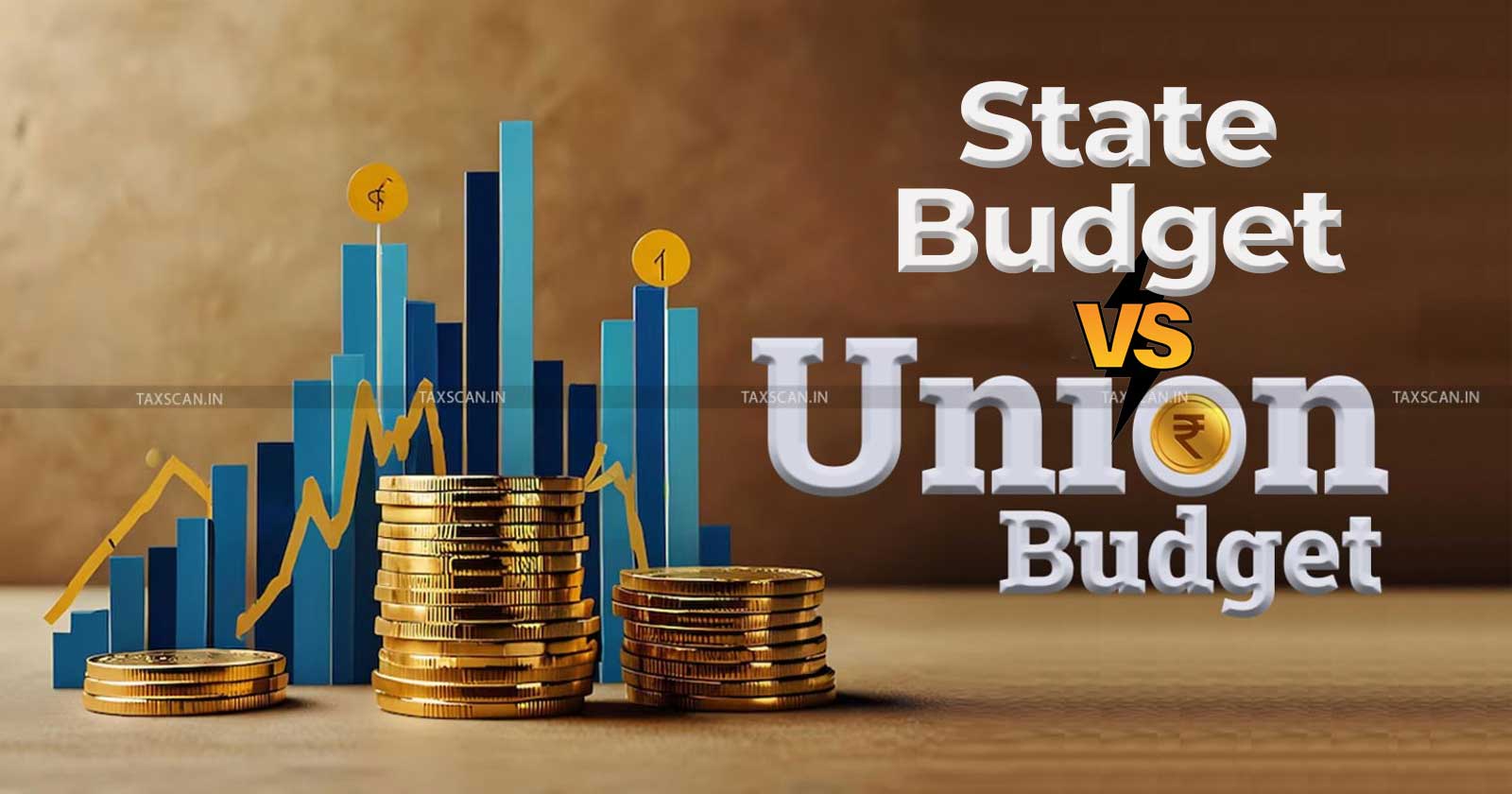State Budgets v/s Union Budget: Key Differences
The Annual Union Budget 2025-26 is set to take place on February 1, 2025 following which State Budgets shall be presented on a gradual basis

State Budgets – Union Budget – difference between state and union budget – Union Budget 2025 – Nirmala Sitharaman – taxscan
State Budgets – Union Budget – difference between state and union budget – Union Budget 2025 – Nirmala Sitharaman – taxscan
With India set to receive the Union Budget 2025-26 on February 1, 2025, the finance verse is abuzz with the probable inclusions and changes to existing policies that may be effectuated by the Budget. The Union Budget 2025-26 shall be spearheaded by Union Finance Minister Nirmala Sitharaman in her record 8th budget presentation.
The Indian system of governance splits powers between the Union Government operating at the Centre, the individual State Government and Local Government bodies such as Municipal Corporations and Panchayats. All 3 of these limbs prepare their own budgets to conduct activities relevant to their scope of work and jurisdiction. Read on to get a brief idea of the differences between Union and State Budgets, how the same are utilized and the consonance between them.
Union Budget:
The Union budget is an estimate of the Nation’s budget prepared by the Government of India every year, detailing its revenue, planned expenditures and proposed changes for the upcoming fiscal year. The Union Budget plays a key role in understanding the financial position of the nation and what steps or schemes are being actively pursued for the future.
Read More: Insights from Past Budgets: Trends and Patterns to Watch
Article 112 of the Indian Constitution effectuates the Union Budget of India, calling for the provision of an Annual Financial Statement that shall be tabled before both the Houses of Parliament including the sums required to meet expenditure described by the Constitution and the expenditure made from the Consolidated Fund of India for the very same purpose.
A number of key terms are used to define and devise the Union Budget, some of them being:
Fiscal Deficit: The gap that occurs when the spending of a Government exceeds its revenue reserves.
Direct Taxes: Taxes levied directly on individuals or entities, such as income tax and corporate tax.
Indirect Taxes: Taxes charged on producers or suppliers, which are ultimately borne by consumers, an example being the Goods and Services Tax (GST) introduced in 2017.
Non-Plan Expenditure: Spending related to areas like interest payments, defense, subsidies, police force, pensions, and other government services.
Plan Expenditure: Funds allocated to implement the Central Plan and provide financial support to states and union territories.
The Union Budget is prepared as a joint effort between the 2 key nodal bodies of the Ministry of Finance, namely the Department of Revenue and the Department of Expenditure and is driven into action after extensive discussions with various ministries and reviewed by the Finance Minister, Prime Minister and top officials within the Department.
Union Budgets are usually presented on the first day of February each year.
Read More: What’s Cooking? Pre-Budget ‘Halwa Ceremony’ – the What, How, When and Why
State Budgets:
While Union Budgets are concerned with the economic functioning of the entire nation, State Budgets are devised with the tunnel vision restricted to the receipts and expenditures of the respective states for each financial year.
According to Article 202 of the Constitution of India, the Governor of a State is required to present the State Budget before the State Legislature. This statement, referred to in the Constitution as the "Annual Financial Statement," is commonly recognized as the "State Budget."
State Governments’ accounts are primarily split into 3 parts: Consolidated Fund of the State, Contingency Fund of the State and the Public Accounts of the State
The Consolidated Fund of the State includes all revenues received by the government, loans raised, and recoveries of loans made by the State. Expenditure from the Consolidated Fund mandates legislative approval, either through votes or charged appropriations as provided for by the Constitution included in the Annual Financial Statement.
Charged appropriation refers to expenditure from the Consolidated Fund of a State or the Union that is not subject to a vote by the legislature. Instead, it is directly charged on the Consolidated Fund as mandated by the Constitution. This means such expenditures are obligatory and must be paid before any other expenses.
The Contingency Fund, established under Article 267(2) of the Constitution and parallel State Contingency Fund Acts, is a notional fund used for unforeseen and emergent expenses that may be utilized without prior legislative approval. The Governor authorizes such expenditure, subject to post-facto legislative sanction. Advances from this fund are recouped through provisions in the Supplementary Budget.
The Public Account, as per Article 266(2) of the Constitution of India, contains public money that is not credited to the Consolidated Fund. It includes unfunded debts (such as Provident Fund contributions), deposits and advances, reserve funds, and remittances. The funds within Public Accounts are largely transactional, where the government plays the role of a banker by receiving and holding onto amounts before paying them off for the expenditures incurred by the
The Finance Commission proposes the apt distribution of funds between the State and Union Governments, placing reliance on Income tax, basic excise duty, additional excise duty and Custom Duty among others.
Read More: Union Budget 2025: Know Date and Time of Budget Speech by Finance Minister
Interim Budget:
An interim budget is a financial statement presented by the government during the transition period when the Government is not in a position to introduce a full-fledged budget. Governments in India usually end up introducing interim budgets during an election year or under exceptional circumstances when the ruling government is nearing its period of governance, and cannot make major policy decisions for the full financial year, which may be regulated by the incoming Government.
Dissimilar to a regular budget, an interim budget is a temporary measure instituted to avert any disruptions in the regular economic functioning of the Government. It primarily comprises two key elements: an interim financial statement detailing expenditures and revenues, and a vote on account, which requires approval from the Parliament to withdraw funds from the Consolidated Fund to meet expenses for the period in which the interim budget shall be in force.
Can both the Union and State Government present Interim Budgets?
Both the Union and State Governments in India can present interim budgets during transitional periods, such as impending general or state elections. At the national level, the Union interim budget is presented in Parliament to cover essential expenditures and revenues for a limited duration (typically two to four months) until a new government assumes office and introduces a full budget.
Similarly, states present interim budgets to their Legislative Assemblies under comparable circumstances, ensuring financial continuity without proposing long-term policies. While the structure and purpose are the same, interim budgets at both levels focus on maintaining basic governance until the next government takes charge.
In both cases, the interim budget includes a vote on account, which seeks legislative approval for withdrawing funds from the Consolidated Fund to meet short-term expenditures. It avoids significant policy changes or long-term commitments, as these are usually left to the incoming government.
While the Union Budget addresses the macroeconomic framework of the country, State Budgets focus on localized needs. Together, they form a cohesive financial system that caters to India’s diverse governance structure.
Support our journalism by subscribing to Taxscan premium. Follow us on Telegram for quick updates


